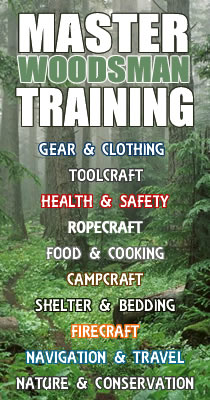When it comes to Tree ID, we do have a few books listed in our bibliography, but not many in lieu of the geographical nature of the subject. Nonetheless, below is a list of online resources to get you started. Also, HERE is a link to a Master Woodsman article and video on the subject of ID.
While plants are the foundation of Woodcraft, I would like to take this opportunity to state that (in my opinion) learning edible plants should not be as high a priority as learning plants for fire, shelter, tools, medicine, traps/deadfalls and wildlife-use first (plants are what the real food eats < joke).
Learning wild edibles is great and I encourage you to do so, but it takes a long-term commitment of learning positive identification, the right part, season, preparation, poisonous look-a-likes, etc. If your priority is wilderness survival, food will be of little concern >>—> see this ARTICLE.
If you are determined to learn edibles (for survival in particular), a good place to start is getting comfortable with those that are relatively common and easy to identify… cattail, inner pine bark, and acorns. Grass is another easy one, just make sure it is a grass and be aware of a fungus called ergot.
Harvesting Ethics
Most Native American tribes follow this practice when harvesting plant life.
Only take the fourth plant. The first is left to seed so you will have more next year. The second is left for wildlife. The third is for someone else who may really need the plant. The fourth you may harvest.
Also think ecologically. If you take a branch or whole tree, take what is suppressed to begin with. By pruning or harvesting that which will likely be infested with disease and/or insects and die anyway, you are doing the forest a favor. You may be doing yourself a favor too in that the suppressed tree will have much tighter growth rings for strength.
As an example, a suppressed tree will make a much stronger bow than a healthy quick growing tree. A win-win where man can take from the land and improve it at the same time.
———–
General Info and ID
USDA Plants Database
Silvics of North America
Virginia Tech Dendrology (see their mobile app, vTree for North America!)
Wildflowers of U.S.
Southeastern Flora
Trees of Southeast (includes quizzes)
Desert USA
Weed ID (eastern U.S.)
Pacific Northwest
Michigan, Wisconsin, and surrounding area…
Arizona (Vanderbilt)
Northern Arizona
Desert Plants of Utah
Utah Trees
Identification Keys
Arbor Day Foundation
Virginia Tech Dendrology
Alabama Plants (flowers)
Florida Selector
Western U.S.
Pacific Northwest
Ohio Public Library
Ethnobotany and Uses
Native American Database
Phytochemical and Ethnobotanical Database
Nutritional Database
Botanical
Eat The Weeds
Northeast US Plant Uses
Practical Plants of New England
Pacific NW and Canada Foraging
Healing Trees
Wood Technology – Identification
Basic Guide to ID
Society of Wood Science and Technology
Hobbit House
The Wood Database
Wood Technology – Properties
Society of Wood Science and Technology (see links on Structure and Properties)
Wood Properties USDA Forest Service
Physical Properties of Common Woods
The Wood Database
Strength Properties of Important Woods
Mobile Apps
vTree – free tree ID app for North America. Have to give a two-thumbs up on this one!
Wild Edibles – free and pay versions of “Wildman Steve Brill” edible plants. Primarily focused on northeast U.S., but many are widespread. Well done for a mobile app.
——————————————————-
Prayer of the Woods
“I am the heat of your hearth on the cold winter nights, the friendly shade screening you from the summer sun, and my fruits are refreshing draughts quenching your thirst as you journey on. I am the beam that holds your house, the board of your table, the bed on which you lie, and the timber that builds your boat. I am the handle of your hoe, the door of your homestead, the wood of your cradle, the shell of your coffin. I am the bread of kindness and the flower of beauty. Ye who pass by, listen to my prayer: harm me not.”
– First used in the PORTUGUESE FOREST RESERVES more than 1,000 years ago. Now used on nature trails throughout the world.
Plants have a gazillion uses; the air we breath, food, shelter, indicators of the environment, and so much more. Below is my personal list of plant uses for fire and cordage. Note that I reside in Southern Appalachia and have an affinity for the Deep South where I grew up. For the west coast folks, here is a PDF link to an impressive list of friction fire woods put together by Storm (R.I.P.).
|
BOW DRILL WOODS |
||
| Scientific Name | Common Name | Notes on bow drill features |
| Acer negundo | Box Elder | Easy |
| Acer rubrum | Red Maple | Difficult, wide spread, opposite |
| Aesculus spp. | Buckeye | Easy – Medium |
| Betula alleghaniensis | Yellow Birch | Easy |
| Betula lenta | Black Birch | Medium – Difficult |
| Betula nigra | River Birch | |
| Carpinus caroliniana | Eastern Hop Hornbeam | Difficult |
| Carya spp. | Hickory | Difficult |
| Cersis canadensis | Eastern Redbud | Medium |
| Chamaecyparis thyoides | Atlantic White Cedar | Easy |
| Fagus grandifolia | American Beech | Difficult |
| Fraxinus americana | White Ash | Difficult |
| Juglans nigra | Black Walnut | Difficult ~ must use sapwood |
| Juniperus virginiana | Eastern Red Cedar | Easy – Medium, handles moisture well |
| Liriodendron tulipifera | Yellow Poplar | Easy, especially susceptible to moisture and decomposition |
| Pinus strobus | White Pine | Easy- medium, especially susceptible to moisture |
| Platanus occidentalis | Sycamore | Easy – Medium |
| Populus deltoides | Eastern Cottonwood | Easy |
| Populus deltoides | Eastern Cottonwood Root | Easy |
| Populus grandidentata | Aspen | Easy |
| Prunus serotina | Black Cherry | Difficult |
| Quercus spp. | Red Oak | Difficult |
| Rhus typhina | Staghorn Sumac | Easy |
| Salix spp. | Willow | Easy |
| Sambucus canadensis | Elderberry | Easy – Medium |
| Sassafras albidum | Sassafras | Difficult |
| Tilia americana | American Basswood | Easy |
| Tsuga canadensis | Eastern Hemlock | Medium – Difficult, especially suseptible to moisture |
| Ulmus americana | American Elm | Difficult |
| Verbascum thapsus | Mullein | Easy |
| Viburnum spp. | Viburnum | Medium |
|
Hand Drill Stalks |
|
| Scientific Name | Common Name |
| Acer negundo | Boxelder |
| Aesculus spp. | Buckeye |
| Apocynum cannabinum | Dogbane |
| Cirsium muticum | Thistle |
| Conyza canadensis | Horseweed |
| Dipsacus fullonum | Teasel |
| Epilobium angustifolium | Fireweed |
| Erigeron philadelphicus | Fleabane |
| Helianthus spp. | Sunflower |
| Salix spp. | Willow |
| Sambucus canadensis | Elderberry |
| Solidago spp. | Goldenrod |
| Typha spp. | Cattail |
| Verbascum thapsus | Mullein |
| Yucca filamentosa | Yucca |
|
CORDAGE ~ INNER TREE BARK |
|
| Scientific Name | Common Name |
| Acer negundo | Box Elder |
| Asmina triloba | Paw Paw |
| Carya spp. | Hickory |
| Fraxinus americana | White Ash |
| Juglans cinerea | Butternut |
| Juglans nigra | Black Walnut |
| Juniperus virginiana | Eastern Red Cedar |
| Liriodendron tulipifera | Yellow Poplar |
| Morus rubra | Red Mulberry |
| Populus deltoides | Eastern Cottonwood |
| Prunus serotina | Black Cherry |
| Quercus spp. | Red Oak |
| Robinia pseudoacacia | Black Locust |
| Salix spp. | Willow |
| Tilia americana | American Basswood |
| Ulmus americana | American Elm |
|
CORDAGE ~ WOODY STALKS |
|
| Scientific Name | Common Name |
| Apocynum cannabinum | Dogbane (Indian Hemp)* |
| Abutilon theophrasti | Velvet Leaf |
| Asclepias spp. | Milkweed |
| Oenothera biennis | Eveningprimrose |
| Urtica dioica | Stinging Nettle* |
| * Strong for bow string | |
|
CORDAGE ~ LEAVES |
|
| Scientific Name | Common Name |
| Arecaceae Family | Palm |
| Hemerocallis fulva | Daylily |
| Iris spp. | Iris |
| Scirpus tabernaemontani | Bullrush |
| Typha spp. | Cattail |
| Yucca filamentosa | Yucca* |
| * Strong for bow string | |
|
CORDAGE ~ GRASSES |
|
| Poaceae Family | Pretty much any long stem |
|
CORDAGE ~ ROOTLETS |
|
| Scientific Name | Common Name |
| Cupressaceae (Cypress) Family | Red Cedar, Cypress, White Cedar |
| Juglans cinerea | Butternut |
| Morus rubra | Red Mulberry |
| Picea rubens | Red Spruce |
| Pinaceae Family | Pines, Hemlock |
| Robinia pseudoacacia | Black Locust |
| Salix spp. | Willow |
| Ulmus spp. | Elm |
|
CORDAGE ~ VINE (or vine bark) |
|
| Scientific Name | Common Name |
| Lonicera spp. | Honeysuckle |
| Parthenocissis quinquefolia | Virgina Creeper |
| Pueraria montana | Kudzu |
| Rosa spp. | Rose |
| Smilax spp. | Greenbriar |
| Vitis spp. | Grape / Muscadine |
|
CORDAGE ~ WOOD FIBERS |
|
| Scientific Name | Common Name |
| Fagus grandifolia | Beech |
| Fraxinus americana | Ash |
| Prunus serotina | Black Cherry |
| Quercus spp. | Oak |
| Viburnum spp. | Viburnum |







